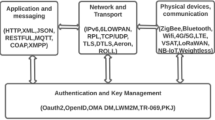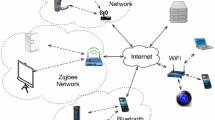Abstract
The creation of smart cities using IoT-enabled technology has resulted in considerable improvements in operational efficiency and service quality. However, as smart city networks expand, the possibility of cybersecurity attacks and threats increases, which can cause IoT devices to malfunction and potentially threaten people's lives. This study investigates the use of various machine learning algorithms like LR, DT, SVM, RF, ANN, and KNN in smart city networks to sense assaults and anomalies. Ensemble approaches like boosting, bagging, as well as stacking are also used to improve the detection system’s effectiveness. The suggested technique effectively identifies cyberattacks, according to experimental data, and the ensemble technique like stacking beats previous models with enhanced accuracy as well as other performance metrics. This study emphasizes the potential of employing machine learning algorithms and ensemble approaches to identify cyberattacks in IoT-based smart cities, as well as the necessity of the selection of relevant features with cross-validation techniques for increased accuracy and performance.
Access this chapter
Tax calculation will be finalised at checkout
Purchases are for personal use only
Similar content being viewed by others
References
Chowdhury A, Karmakar G, Kamruzzaman J (2019) The co-evolution of cloud and IoT applications. igi-global.com, pp 213–234
Pahl MO, Aubet FX, Liebald S (2018) Graph-based IoT microservice security. In: IEEE/IFIP network operations and management symposium: cognitive management in a cyber world, NOMS 2018, pp 1–3
Symantec (2020) Internet security threat report. Symantec Tempe, AZ, USA, p 1
Yousefpour A, Ishigaki G, Jue JP (2017) Fog computing: towards minimizing delay in the Internet of Things. In: Proceedings of IEEE 1st international conference on edge computing EDGE, pp 17–24
Diro AA, Chilamkurti N (2018) Distributed attack detection scheme using deep learning approach for Internet of Things. Futur Gener Comput Syst 82:761–768
Ludwig SA (2019) Applying a neural network ensemble to intrusion detection. J Artif Intell Soft Comput Res 9(3):177–188
Zhang K, Zhu Y, Maharjan S, Zhang Y (2019) Edge intelligence and blockchain empowered 5G beyond for the Industrial Internet of Things. IEEE Netw 33(5):12–19
Benkhelifa E, Welsh T, Hamouda W (2018) A critical review of practices and challenges in intrusion detection systems for IoT: toward universal and resilient systems. IEEE Commun Surv Tutorials 20(4):3496–3509
Zhang K, Leng S, Peng X, Pan L, Maharjan S, Zhang Y (2019) Artificial intelligence inspired transmission scheduling in cognitive vehicular communications and networks. IEEE Internet Things J 6(2):1987–1997
Pahl M, Aubet F (2018) All eyes on you: distributed multi-dimensional IoT microservice anomaly detection. In: 14th International conference on network and service management (CNSM). IEEE, pp 72–80
Haq NF, Onik AR, Shah FM (2015) An ensemble framework of anomaly detection using hybridized feature selection approach (HFSA). In: IntelliSys 2015—Proceedings of 2015 SAI intelligent systems conference, pp 989–995
Gaikwad DP, Thool RC (2015) Intrusion detection system using bagging ensemble method of machine learning. In Proceedings—1st international conference on computing, communication, control and automation, ICCUBEA, pp 291–295
Jabbar MA, Aluvalu R, Sai Satyanarayana Reddy S (2017) Cluster based ensemble classification for intrusion detection system. In: ACM international conference proceeding series, F1283, pp 253–257
Pham NT, Foo E, Suriadi S, Jeffrey H, Lahza HFM (2018) Improving performance of intrusion detection system using ensemble methods and feature selection. In: ACM International conference proceeding series
Tavallaee M, Bagheri E, Lu W, Ghorbani AA (2009) A detailed analysis of the KDD CUP 99 data set. In: IEEE symposium on computational intelligence for security and defense applications, CISDA
Khraisat A, Gondal I, Vamplew P, Kamruzzaman J, Alazab A (2019) A novel ensemble of hybrid intrusion detection system for detecting internet of things attacks. Electronics 8(11)
Koroniotis N, Moustafa N, Sitnikova E, Turnbull B (2019) Towards the development of realistic botnet dataset in the Internet of Things for network forensic analytics: Bot-IoT dataset. Futur Gener Comput Syst 100:779–796
Alrashdi I, Alqazzaz A, Aloufi E, Alharthi R, Zohdy M, Ming H (2019) AD-IoT: Anomaly detection of IoT cyberattacks in smart city using machine learning. In: 2019 IEEE 9th annual computing and communication workshop and conference CCWC 2019, pp 305–310
Zhou Y, Cheng G, Jiang S, Dai M (2020) Building an efficient intrusion detection system based on feature selection and ensemble classifier. Comput Netw 174
Kolias C, Kambourakis G, Stavrou A, Gritzalis S (2016) Intrusion detection in 802.11 networks: empirical evaluation of threats and a public dataset. IEEE Commun Surv Tutorials 18(1):184–208
Sharafaldin I, Lashkari AH, Ghorbani AA (2018) Toward generating a new intrusion detection dataset and intrusion traffic characterization. In: Proceedings of the 4th ICISSP, pp 108–116
Besharati E, Naderan M, Namjoo E (2019) LR-HIDS: logistic regression host-based intrusion detection system for cloud environments. J Ambient Intell Humaniz Comput 10(9):3669–3692. https://doi.org/10.1007/s12652-018-1093-8
Zarpelão BB, Miani RS, Kawakani CT, de Alvarenga SC (2017) A survey of intrusion detection in Internet of Things. J Netw Comput Appl 84:25–37
Moustafa N, Slay J (2016) The evaluation of network anomaly detection systems: statistical analysis of the UNSW-NB15 data set and the comparison with the KDD99 data set. Inf Secur J 25(1–3):18–31
Moustafa N (2017) Designing an online and reliable statistical anomaly detection framework for dealing with large high-speed network traffic. In: Ph.D. Thesis, University New South Wales, Canberra, Australia
Mohammed MA (2021) A multi-agent feature selection and hybrid classification model for Parkinson’s disease diagnosis. ACM Trans Multimed Comput Commun Appl 17(2s)
Hansen LK, Salamon P (1990) Neural network ensembles. IEEE Trans Pattern Anal Mach Intell 12(10):993–1001
Odegua RO (2020) An empirical study of ensemble techniques (bagging, boosting and stacking). Deep Learn. IndabaX 12(10):1683
Vinayakumar R, Alazab M, Soman KP, Poornachandran P, Al-Nemrat A, Venkatraman S (2019) Deep learning approach for intelligent intrusion detection system. IEEE Access 7:41525–41550
Author information
Authors and Affiliations
Corresponding author
Editor information
Editors and Affiliations
Rights and permissions
Copyright information
© 2023 The Author(s), under exclusive license to Springer Nature Singapore Pte Ltd.
About this paper
Cite this paper
Gore, S., Deshpande, A.S., Mahankale, N., Singha, S., Lokhande, D.B. (2023). A Machine Learning-Based Detection of IoT Cyberattacks in Smart City Application. In: Fong, S., Dey, N., Joshi, A. (eds) ICT Analysis and Applications. ICT4SD 2023. Lecture Notes in Networks and Systems, vol 782. Springer, Singapore. https://doi.org/10.1007/978-981-99-6568-7_8
Download citation
DOI: https://doi.org/10.1007/978-981-99-6568-7_8
Published:
Publisher Name: Springer, Singapore
Print ISBN: 978-981-99-6567-0
Online ISBN: 978-981-99-6568-7
eBook Packages: Intelligent Technologies and RoboticsIntelligent Technologies and Robotics (R0)




